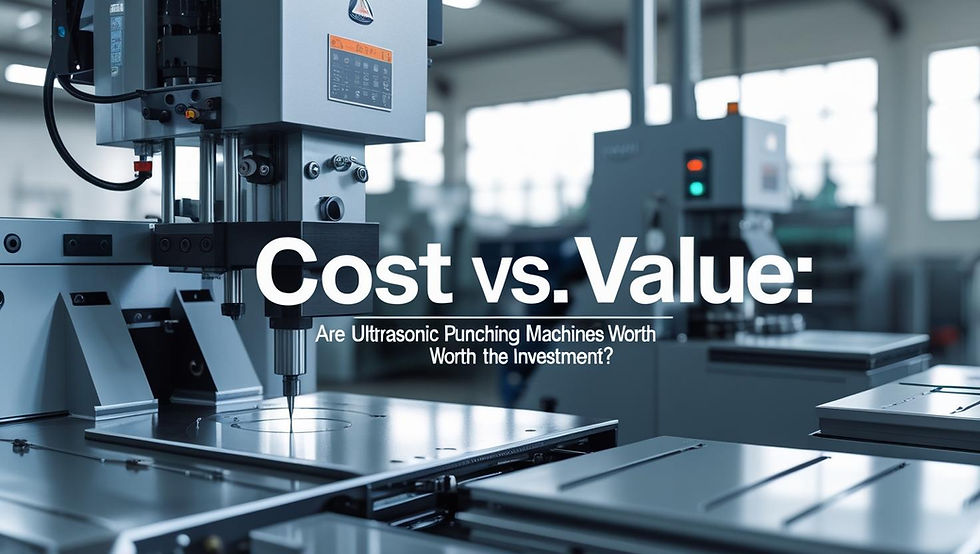Ultrasonic Welding Market Trends, Demand, Size, and More
- ztzgsteeltech
- May 12
- 3 min read

Ultrasonic welding has become a cornerstone in modern manufacturing, offering a clean, efficient, and precise method for joining materials. As someone deeply involved in this industry, I've witnessed firsthand how ultrasonic welding machines have transformed production lines across various sectors. In this article, I'll delve into the current market trends, demand, size, and future outlook of ultrasonic welding, providing insights that are both informative and practical.
Understanding Ultrasonic Welding
Ultrasonic welding is a process that uses high-frequency ultrasonic acoustic vibrations to create solid-state welds between materials, typically plastics or metals. Unlike traditional welding methods, it doesn't require bolts, nails, or adhesives, making it a cleaner and more efficient option. This technology is widely used in industries such as automotive, electronics, medical devices, and packaging.
Market Size and Growth
The global ultrasonic welding market has been experiencing steady growth. In 2024, the market was valued at approximately USD 0.61 billion and is projected to reach USD 0.91 billion by 2033, growing at a CAGR of 4.6% during the forecast period . This growth is driven by increasing demand for efficient and reliable welding solutions across various industries.
Key Market Trends
1. Technological Advancements
The integration of automation and smart technologies into ultrasonic welding machines is a significant trend. Manufacturers are developing machines with real-time monitoring and control capabilities, enhancing precision and efficiency. This evolution is particularly beneficial for industries requiring high-volume production with consistent quality.
2. Growing Demand in Automotive Industry
The automotive sector is a major contributor to the ultrasonic welding market. With the rise of electric vehicles (EVs), there's an increased need for lightweight and durable components, which ultrasonic welding can effectively produce. The process is used for assembling various parts, including battery components and interior features.
3. Expansion in Medical Device Manufacturing
Ultrasonic welding is essential in the medical industry for producing items like filters, masks, and IV catheters. The process ensures strong, contamination-free seals, which are crucial for medical applications. The global medical ultrasonic welder market is expected to reach USD 217.57 million by 2033, growing at a CAGR of 5.4% from 2025.
Table: Ultrasonic Welding Market Overview by Region and Application (2024–2030)
Region / Application | Market Size (2024) | Projected CAGR (2024–2030) | Key Growth Drivers |
North America | USD 150 million | 4.1% | Demand from automotive and medical device sectors |
Europe | USD 130 million | 3.9% | Focus on sustainable, high-precision manufacturing |
Asia-Pacific | USD 200 million | 5.8% | Industrial expansion in China, India, and South Korea |
Automotive Applications | USD 220 million | 4.7% | EV production, lightweight component assembly |
Medical Devices | USD 85 million | 5.4% | Disposable equipment, sterile production |
Electronics & Packaging | USD 90 million | 4.5% | Micro-assembly, tamper-proof packaging |
Learn about the Ultrasonic Punching Machine here.
Regional Market Insights
Asia-Pacific
The Asia-Pacific region is witnessing rapid industrialization, leading to increased adoption of ultrasonic welding technologies. Countries like China and India are investing heavily in manufacturing sectors, driving demand for advanced welding solutions.
North America
In North America, the focus is on innovation and automation. The region has a strong presence of key market players and is investing in research and development to enhance ultrasonic welding technologies.
Europe
Europe emphasizes sustainable manufacturing practices. The region is adopting ultrasonic welding for its energy efficiency and ability to produce high-quality, recyclable products.
Challenges in the Market
Despite the positive outlook, the ultrasonic welding market faces challenges. High initial investment costs can be a barrier for small and medium-sized enterprises. Additionally, the need for skilled operators and maintenance personnel can hinder adoption in some regions.
Opportunities for Manufacturers and Suppliers
As an ultrasonic welding machine supplier, I see numerous opportunities for growth. Expanding into emerging markets, offering customized solutions, and investing in after-sales services can enhance competitiveness. Collaborating with research institutions can also lead to innovative product developments. For purchasing bulk quantities contact this ultrasonic welding machine supplier right away!
Future Outlook
The future of ultrasonic welding looks promising. With continuous technological advancements and increasing demand across industries, the market is set to grow. Manufacturers and suppliers who adapt to changing needs and invest in innovation will likely thrive in this evolving landscape.
In conclusion, ultrasonic welding is a dynamic and growing field. By staying informed about market trends and focusing on customer needs, businesses can leverage this technology to enhance their manufacturing processes and product quality.



Σχόλια